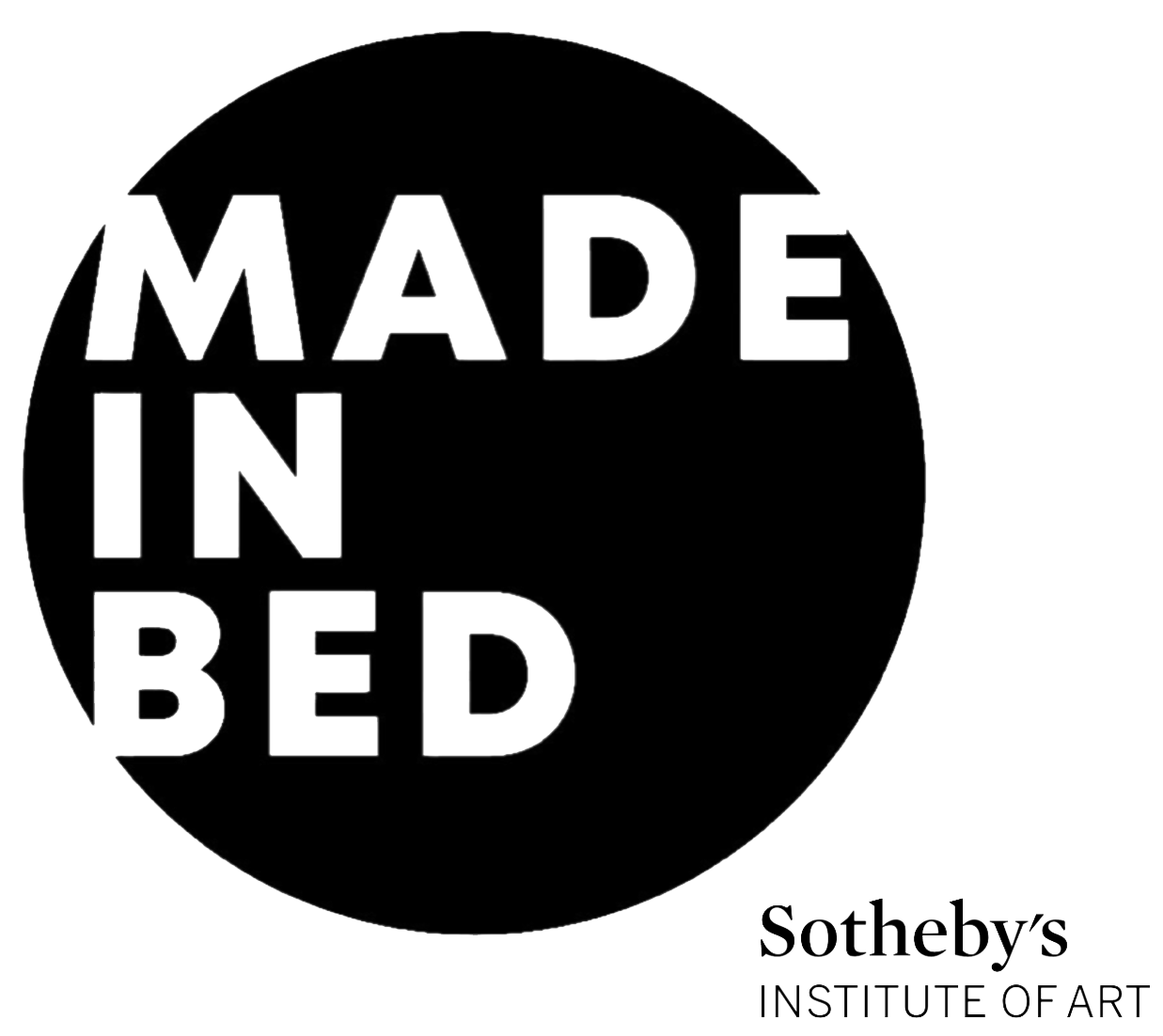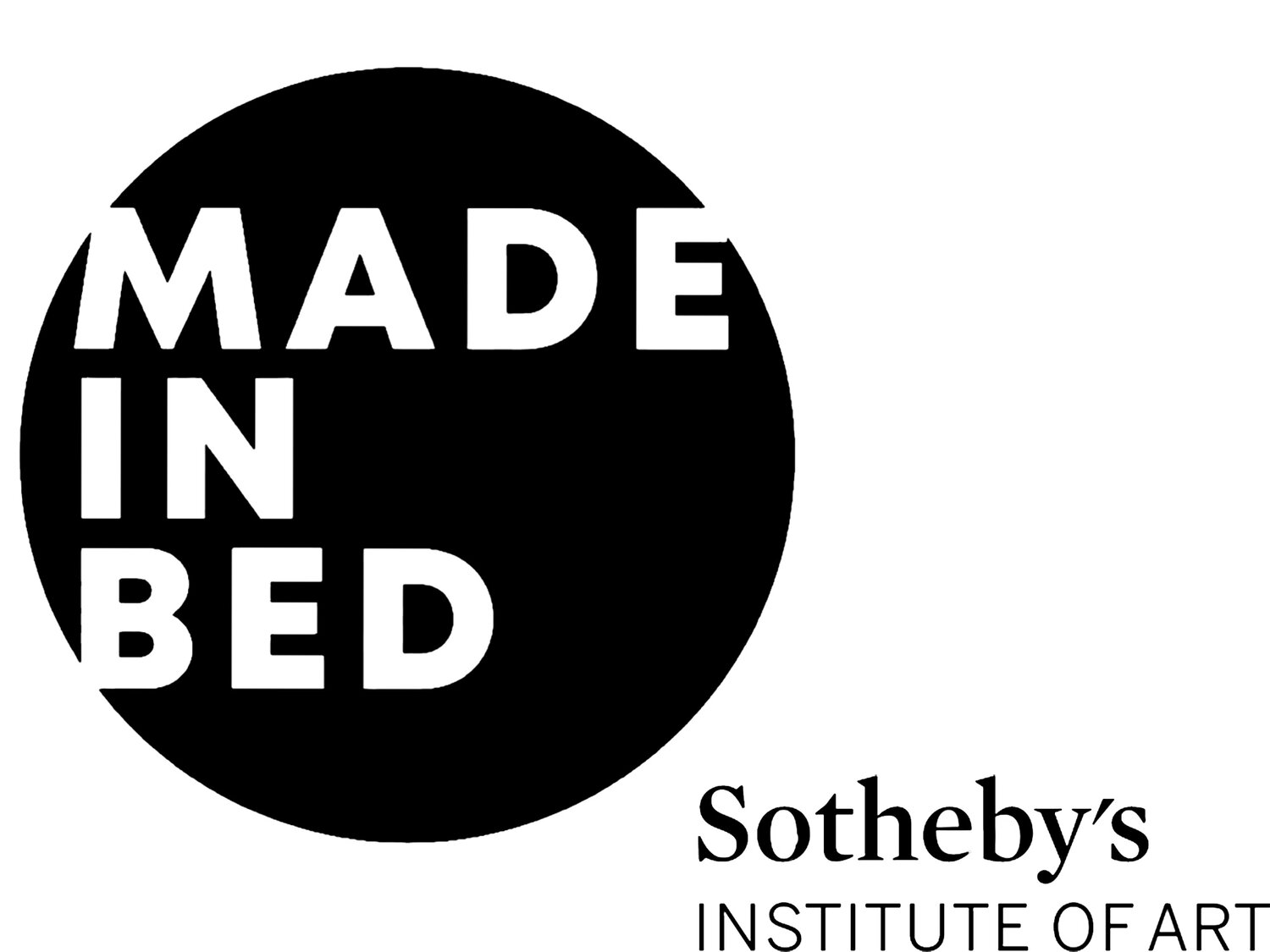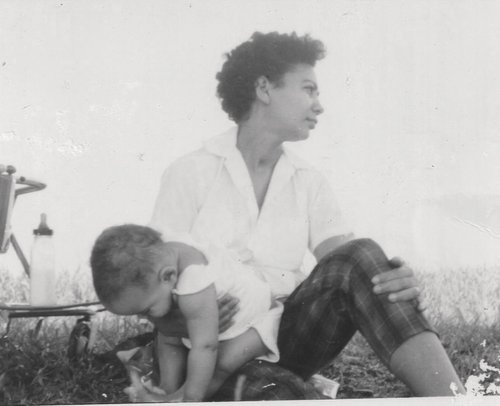Emily Alice Mitchell
Emily Alice Mitchell is a multidisciplinary artist born and working in London. Combining moving image, photography, printmaking, and sculpture, she works to represent the intersections of identities and liminalities of mixedness. Less than one year post graduation from the Royal College of Art, Mitchell has been awarded The John Akomfrah Research Fellowship in partnership with Lisson Gallery and RCA BLK. The prize allows Mitchell to create new work in response to Akomfrah’s British Pavilion exhibition, Listening All Night To The Rain, at the 2024 Venice Biennale.
Emily Alice Mitchell at work. Photo Courtesy: Gugan Gill.
I first met Emily Alice Mitchell at a private view in Peckham at a mutual friend's exhibition, not realising that I already knew and had encountered her artwork through Instagram. Enthralled by Mitchell’s unique attitude towards image making and the vibrancy through which she combines a range of mediums and techniques, I went on to visit her 2024 Master's show at the Royal College of Art in Battersea. Here, Mitchell created an ambitious and diverse display of sculpture, installation, moving image, archival materials, printmaking, and photography, spanning a dynamic spectrum of multi-disciplinary media.
Emily Alice Mitchell, Those who swim within the pilgrimage of my blood (2024). [Two-channel moving image installation] 44 minutes 17 seconds. Photo Courtesy: The artist.
I sat down to interview Mitchell, who describes herself as “mostly a filmmaker”, to explore her practice and interests in image making and photography. Using these mediums allow her to explore the betweenness and mixedness of her Caribbean heritage—specifically Trinidadian—and her British-Scottish identity. Her artworks also draw on themes of migration, focusing on diasporic narratives with sensitivity and specificity.
Mitchell's RCA exhibition included Those who swim within the pilgrimage of my blood (2024), an installation consisting of a two-channel moving image work and five sculptural pieces. Each moving image explores the artist’s maternal and paternal heritage, highlighting the contrasts within their archives, with the heavy absence on Mitchell’s paternal side. It features four sculptural elements suspended by beads resembling her late grandmother’s wooden necklaces. The central sculpture is collaged with images from Mitchell’s archives, carefully placed onto a hymnal board.
Those who swim within the pilgrimage of my blood (2024) is shrine like, a place to worship or bring offerings to ancestors. Yet, Catholic symbolism—such as the cross and rosary-like beads—remind us of the syncretised religions in the Caribbean, emerging from the blending of various African traditions, indigenous beliefs and Christianity.
Mitchell layers and places the installation in front of another artwork, Against my heart (2024), a photo transfer print on textured wallpaper and acrylic. The hand-printed wallpaper takes its title from a poem from a renowned British-Guyanese poet, whose work often reflects on Caribbean migration, identity, and the diasporic experience. Against my heart (2024) includes photographs of the artist’s father and uncle in Grenada, created through photo transfers. It combines family archives with personal experiences of the landscape captured on a visit to the island in August of 2023. Here, Mitchell addresses memory, collective narratives, and generational inheritance, to explore an in-between or hybrid identity.
Emily Alice Mitchell, Always Been Here (2023). Belmont Estate, Grenada. Photo Courtesy: The artist.
The Image
Like many artists, Mitchell initially began with painting, during her BA Fine Art degree at Lancaster University (2020-2023). However, she felt the medium was too restrictive and not boundless enough for the artworks she hoped to create. Previously within her artistic practice, Mitchell had created collages which merged family photos, World War II propaganda posters, newspaper cutouts, and magazine clippings. During University, the importance of the image became even more pertinent through her exploration of family albums, allowing her to emotionally reconnect whilst physically absent from home. Mitchell expresses that she, “cannot step away from the family image, as it is sense of preservation, of hearing everyday stories”.
Through these archives, Mitchell began to create cyanotypes—a method of camera-less photography—and used stop motion techniques to create short films like Beyond the Sea (2022). Inspired by her collage background, use of archival footage, and historical events, Mitchell established her experimental nature towards the image. Through the RCA Contemporary Art Practice MA (2023-2024), she received further freedom to explore these mediums within a critical context.
Emily Alice Mitchell, Beyond the Sea (2022). [Moving image] 1 minute, 50 seconds. Photo Courtesy: The artist.
Archives
The archive is critical to Mitchell’s practice, believing it should be an active, growing and dynamic collection. Often referring to a physical collection housing historical records and materials, the archive seeks to document information or evidence about past events or individuals. Simultaneously, there are several layers and politics of representation as an archive can largely be an exclusionary environment with a bias and gravitation that may exclude many communities, due to the construction and exclusion of certain histories. Additionally, the changing technologies and preservation of footage can lead to an erasure or loss of certain groups or communities. This knowledge urges and reveals how narratives can be shifted through decolonial archival practices.
Through her practice Mitchell aims to address some of these concerns. By using her own family archival images, conducting research and even working professionally within an archive, Mitchell explores “...the current, as well as past histories”.
Triptych, Frank Collymore. Comprised of inherited books from Mitchell’s granny. Photo Courtesy: Gla’s Archive.
Emily Alice Mitchell, Triptych (2024). [Photo transfers on inherited spoon display holders] 160cm x 38cm. Photo Courtesy: The artist.
Kinky Hair and Brown Baby Blues. Family photograph. Photo Courtesy: Gla’s Archive
Words and Water
As critical as the image is to Mitchell’s practice, so is the written word. Mitchell always titles her work using poetry, and she utilises a range of texts—from notes, newspapers, journals and archives to novels—within her artworks. Mitchell cites her grandmother as a major source of inspiration behind her practice; who as a member of the Windrush generation migrated to the UK in 1967. Her grandmother, whom she affectionally refers to as “granny”, was heavily inspired by Carribean literature during her lifetime. The artist inherited her book collection when she passed away, which instantly became a constant resource for Mitchell.
On a visit to Trinidad and Tobago in 2023, the artist recorded car journeys around the Island. She had a passion to voraciously document everything, particularly the surrounding environments of San Fernando and Diego Martin. “The most significant thing I filmed was the water”, says Mitchell. The Atlantic Ocean is a main point within her work—a body of water so vast and deeply interlinked with painful histories of British colonialism. However, seeing the ocean from Trinidad allowed the artist to view the separation from her motherland from a different perspective. Not longing to belong, distant and far away in England, but finally in the place she had been reaching for through archives, images and words.
In this seemingly new place, the artist created works using sounds, sights and senses she had never experienced before, collaged with phone recordings of her grandmother. Mitchell’s practice flows from the deep in many ways, yet she agilely works to articulate the often-difficult, unutterable, thoughts and feelings of a person between many worlds.
Welcome to Trinidad Calypso, Johnny Sparrow. Comprised of inherited books from Mitchell’s granny. Photo Courtesy: Gla’s Archive.
Epilogue
I have crossed an ocean
I have lost my tongue
From the root of the old one
A new one has sprung
Grace Nichols
Emily Alice Mitchell, You were Flesh and salt (2023). [Moving image] 6 minutes, 49 seconds. Photo Courtesy: the artist.
Inspirations
The artist has several creative inspirations, particularly black artists and cultural writers. Key influences include John Akomfrah and The Black Audio Film Collective—whose works notably inspires multi-channel pieces, such as You were Flesh and salt (2023). Another source is Tina Campt’s book Listening to Images (2017), in which Campt explores the archive as a place of resistance that requires deeper attention. Mitchell also expresses that she is a big fan of the artist Alberta Whittle, who also explores the duality of her Scottish-Caribbean heritage. The specificity of this speaks directly to Mitchell’s heritage and allows her to see different ways of piecing together ideas through different mediums. Additionally, the artist cites Guyanese-British artist Hew Locke, whose recent exhibition ‘What Have We Here?’ at the British Museum (2024-2025) interrogated its colonial collections.
It is not an easy time to be emerging. Artists are chronically underfunded, markets fluctuate, and we forget the artists and their artworks are at the centre of it all. For many emerging artists there is a sense of uncertainty following graduation, with many having to take on full-time job roles to fund and sustain a separate creative making practice. As a result, it can be difficult to manage time and energy. It can also be a fragile moment for artists who share artworks so closely related to identity. Despite this, Mitchell has carried on making and is excited about what the future will bring.
Emily Alice Mitchell, Incredulous, expecting occupancy (2023). [Series of eight photographs]. Belmont Estate, Grenada. Photo Courtesy: The artist.
In late 2024, Emily Alice Mitchell was awarded the John Akomfrah Research Fellowship by The Royal College of Art's Association of Black Student Alumni and Friends (RCA BLK) and Lisson Gallery. The award includes £3,500 for a three-month fixed-term research project, as well as expenses towards a trip to Venice Biennale and the British Pavilion installation, Listening All Night to the Rain. Judged by a panel including writer and curator Ekow Eshun; the chair of RCA BLK and artist, Emily Moore and Lisson Gallery’s Ossian Ward.
This Fellowship encourages individual and expansive responses to the work of John Akomfrah and its related themes, in advance of a major monograph to be published on the artist.
The space and time given to Mitchell through the Fellowship, highlight her exceptional ability to address cultural and historical narratives with depth. This also positions her as a fresh and dynamic voice for a new generation of artists working with images.
Selected Exhibitions
2024 - Ripples, Hypha Studios: Sugar House Island, London [Group exhibition]
2024 - RCA Graduate Show, Royal College of Art, London [Group exhibition]
2024 - Grandma. Nani Ji. Teta. Jada. Granny. Nan. Royal College of Art, London [Group exhibition]
2024 - CAP Cinema: Towards Levitation, Tate Modern, London [Group exhibition]
2024 - CAP Cinema: Towards Levitation, Genesis Cinema, London [Group exhibition]
2024 - I Am Not Cruel, Only Truthful, Hockney Gallery, Royal College of Art, London [Group exhibition]
2024 - I Am the Hell and the High Water, Royal College of Art, Pending Gallery, London [Group exhibition]
2023-24 - The Next Thing Moving Image Award, Bury Art Museum, Bury [Group exhibition]
2023 - & Smiled, SET Kensington, London [Group exhibition]
2023 -Made It 2023, The Royal Standard, Liverpool [Group exhibition]
2023 - Windrush 75, National Maritime Museum, London [Commission]
2023 -Disruption, LICA @ Lancaster University [Group exhibition]
2023 -You were Water to me, JEWELLERII, Morecambe [Solo exhibition]
2023 -Uninterrupted, The Gregson Centre, Lancaster [Group exhibition]
2022 -Adaption, The Storey, Lancaster [Group exhibition]
Publications
2024 -CAP: Towards Levitation, London
2024 -Black Nature In Residence Zine, Issue 02: Spring, Newcastle
2023 -Zindabad, Issue 003: Food, Oxford
Tobi Alexandra Falade
Emerging Artist Co-Editor, MADE IN BED














